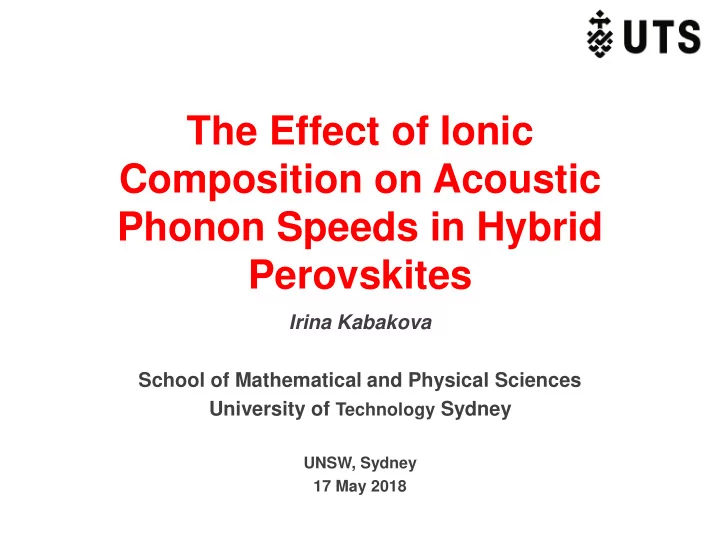

The Effect of Ionic Composition on Acoustic Phonon Speeds in Hybrid Perovskites Irina Kabakova School of Mathematical and Physical Sciences University of Technology Sydney UNSW, Sydney 17 May 2018
Motivation Hybrid organic-inorganic perovskites HOIP applications : • Solar energy, LEDs, lasers; • HOIP solar cell efficiency >20%; • Low cost fabrication; • Deposition on corrugated/flexible/structured surfaces; Open questions: • Mechanical and chemical stability; • Temperature-related structural changes; • Role of phonons in the charge-carrier scattering; • Tailoring electric and mechanical properties by ionic composition. Zhao&Zhu “Organic -inorganic hybrid lead halide perovskites for optoelectronic and electronic applications,” Chem. Soc. Rev. 45, 655 (2016).
Motivation Ionic composition and charge mobility • Charge career mobility varies with ionic composition • Two factors are found to influence charge-career mobility 1. Intrinsic effects – charge interactions with the underlying lattice 2. Extrinsic effects – material imperfections (lattice disorder, impurities etc.)
Motivation Elastic properties and charge mobility - Carrier-charge mobility C - Elastic constant d - Conductance/valence band deformation potential
GOAL: study mechanical properties of HOIPs with variation of A- and X-sites MAPbCl 3 methylammonium (MA) lead chloride MAPbCl x Br 1-x MAPbBr 3 FAPbBr 3 formamidinium (FA) lead bromide Outline • Fabrication of samples • Clarification of mixture crystal composition • Brillouin spectroscopy measurements • Density functional theory calculations • Discussion of the results • Outlook
Crystal fabrication Dr Zhuoying Chen ESPCI Paris • Crystals are prepared by dissolving MACl/MABr and PbCl 2 into solution • The mixture is kept in an oil bath for 12 hr at 55 ° C • Formed crystals are dried under vacuum at 50 ° C for 6 hours • Typical crystal size obtained – 1m 3 • The color varies from transparent (Cl) to yellow (ClBr) to bright orange (Br) Dr Pabitra Nayak Oxford University
XRD measurements 60% Cl 40% Br
Brillouin light scattering Sound Light Frequency f ~ MHz-GHz Frequency f ~ 100 THz Speed in vacuum c = 3 10 8 m/s Speed in water v = 1470 m/s Wavelength λ ~500nm (f~GHz) Wavelength λ ~ 500 nm Thermal pressure waves Brillouin light scattering (BLS) Incident light Scattered light θ ω ω ± Ω B Ω Acoustic wave
Brillouin light scattering Acoustic waves - collective motion of particles/molecules
Brillouin light scattering in crystals Energy conservation Scattered light Incident light w s = w i ±W ω i ω s θ Phase matching k B @ 2 k i cos q Ω Brillouin frequency shift v × k B = 4 p n Acoustic wave W = l v cos q In crystals with cubic symmetry Christoffel’s equation holds 3 independent elastic constants C 11 , C 12 , C 44 and 3 acoustic waves QL, QT, T é ù det C ijkl n j n l - r v 2 d ik û = 0 ë
Experimental setup for Brillouin spectroscopy
Brillouin measurement results
Brillouin measurement results Brillouin spectra measured from the top and for a 90 ° -rotated (side) MAPbCl 3 crystal. The difference between the Brillouin shift for each type of the acoustic mode is within ~100-200 MHz.
Density functional theory calculations Ido Azuri Leeor Kronik David Egger • Periodic DFT calculations using VASP plane wave code (open source computer program for atomic scale material modeling developed by a research group in Vienna) • Elastic constants are calculated by perturbation theory as implemented in VASP • Christoffel’s equation is used to obtain acoustic velocities
Experiment and theory in comparison Agreement between theory and experiment within 10% Agreement with previous studies* within 20% *Letoublon et. al. Phys. Chem. Lett. 2016, 7, 3776-3784 *J. Feng APL Mater. 2014, 2, 081801
Substitution of X-site MAPbBr 3 -> MAPbCl x Br 1-x -> MAPbCl 3
Substitution of A-site FAPbBr 3 -> MAPbBr 3
Elastic anisotropy Elastic anisotropy*: v T /v L =44% for MAPbCl 3 and v T /v L =62% for FAPbBr 3 *J. Feng APL Mater. 2014, 2, 081801
Outlook • Exploring electronic properties and carrier mobility • Exploring line shape of Brillouin peaks (can be linked to dynamic lattices and non-harmonic phonon states) • Temperature-dependent study (phase transitions) • For these all a higher resolution and higher sensitivity Brillouin system is required. This is currently being build at UTS.
Thank you!
Recommend
More recommend